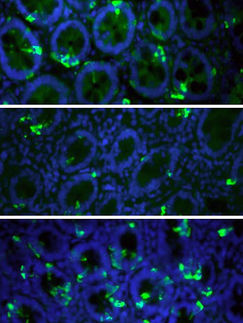Uncovering the molecular basis of obesity
Researchers discover the molecule that links spontaneous physical activity and food intake in mice
Why does the same diet make some of us gain more weight than others? The answer could be a molecule called Bsx, as scientists from the European molecular biology Laboratory [EMBL], the German Institute for Nutrition [DIFE], Potsdam, and the University of Cincinnati report in the current issue of Cell metabolism. Bsx is the molecular link between spontaneous physical activity and food intake. Mice lacking the molecule show less spontaneous physical activity, perceive hunger signals differently and have a lower concentration of feeding hormones in their brain than normal mice. Being conserved across species, Bsx might be a promising target for controlling diet-induced obesity in humans.
Spontaneous physical activity, subconscious movements we make such as fidgeting while working at the computer, and food intake are two crucial factors regulating our body weight. Both are controlled by the same part of the brain, called hypothalamus, and they are intrinsically linked. When we are hungry, our spontaneous activity increases and provides us with the drive to go out and find food. Mathias Treier and his group at EMBL have now discovered the molecule that brings about this link between locomotor activity and food intake in mice.
"The molecule is called Bsx and is required for spontaneous activity," Treier says. "Mice that lack Bsx in their hypothalamus are a lot lazier than normal mice. They show less spontaneous activity and less food seeking behaviour, which is based on locomotor activity."
Bsx brings about its effect by regulating the expression of NPY and AgRP, hormones of the hypothalamus that promote feeding. Without Bsx less hormones are made with the result that only rarely the mice go looking for food even if they have been starving for an extended period. The scientists suggest Bsx is also needed to enable brain cells to sense and respond to specific hunger signals from the body - without it the mice do not feel hunger.
"Bsx is conserved across species and very likely plays a similar role in controlling body weight in humans," says Maria Sakkou, who carried out the research in Treier's lab. "Differences in Bsx activity between individuals could help explaining why some people are intrinsically more active than others and less susceptible to diet-induced obesity. Bsx might be the key to why the same diet makes one person fat, while leaving another unaffected."
The insights gained into the molecular mechanisms regulating body weight in mice might serve as a basis for new ways to prevent obesity and resulting diseases such as cardiovascular conditions and diabetes in humans. Bsx is a promising candidate drug target and further research might suggest how it could be used to modulate basic physical activity as a way to protect against diet-induced obesity.
Original publication: Sakkou, M., Wiedmer, P., Anlag, K., Hamm, A, Seuntjens, E., Ettwiller, L., Tschöp, M.H. and Treier, M.; "A role for brain-specific homeobox factor Bsx in the control of hyperphagia and locomotory behavior"; Cell Metabolism 2007.
Most read news
Organizations
Other news from the department science

Get the life science industry in your inbox
By submitting this form you agree that LUMITOS AG will send you the newsletter(s) selected above by email. Your data will not be passed on to third parties. Your data will be stored and processed in accordance with our data protection regulations. LUMITOS may contact you by email for the purpose of advertising or market and opinion surveys. You can revoke your consent at any time without giving reasons to LUMITOS AG, Ernst-Augustin-Str. 2, 12489 Berlin, Germany or by e-mail at revoke@lumitos.com with effect for the future. In addition, each email contains a link to unsubscribe from the corresponding newsletter.





















































